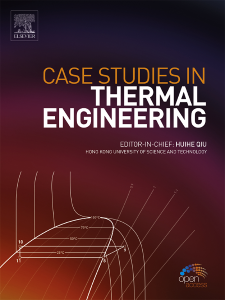Heat pump drying kinetics modeling and prediction for Lentinus edodes based on orthogonal experimental
IF 6.4
2区 工程技术
Q1 THERMODYNAMICS
引用次数: 0
Abstract
To accurately understand the moisture variation and drying characteristics of Lentinus edodes (L. edodes) during the drying process, the kinetics model of L. edodes with a wider application range was investigated. First, the heat pump drying kinetics model for L. edodes was fitted, verified and extended based on the orthogonal experimental data. Then, the expression of moisture ratio of L. edodes with respect to drying time, air supply temperature (AST), loading density (LD) and circulating air volume (CAV) was proposed, and interaction effects of the three key parameters on the drying time were studied based on the prediction model. The findings indicated a substantial agreement between the predicted and experimental values. The drying time could be shortened by increasing the air supply temperature and the circulating air volume or decreasing the loading density. Among these three factors, the AST had the greatest impact on drying time, followed by CAV and LD. For every 48 g/m2 reduction in LD and 11.3 m3/h increase in CAV, the drying time could be reduced by 10.5–29.9 min. Similarly, increasing the AST by 1 °C and the CAV by 11.3 m3/h could decrease the drying time by 13.7–100.6 min. The research results are helpful to optimize the drying process, improve the drying efficiency, and provide guidance and references for practical production of L. edodes HPD.
基于正交实验的热泵干燥动力学建模与预测
为了准确了解 Lentinus edodes(L. edodes)在干燥过程中的水分变化和干燥特性,研究了适用范围更广的 L. edodes 动力学模型。首先,根据正交实验数据拟合、验证和扩展了热泵干燥 L. edodes 的动力学模型。然后,提出了菇类水分比与干燥时间、送风温度(AST)、装载密度(LD)和循环风量(CAV)的关系表达式,并根据预测模型研究了三个关键参数对干燥时间的交互影响。研究结果表明,预测值与实验值基本一致。通过提高送风温度和循环风量或降低装载密度,可以缩短干燥时间。在这三个因素中,AST 对干燥时间的影响最大,其次是 CAV 和 LD。LD 每减少 48 克/平方米,CAV 每增加 11.3 立方米/小时,干燥时间可缩短 10.5-29.9 分钟。同样,AST 增加 1 °C,CAV 增加 11.3 m3/h,干燥时间可减少 13.7-100.6 分钟。研究结果有助于优化干燥工艺,提高干燥效率,并为L. edodes HPD的实际生产提供指导和参考。
本文章由计算机程序翻译,如有差异,请以英文原文为准。
求助全文
约1分钟内获得全文
求助全文
来源期刊

Case Studies in Thermal Engineering
Chemical Engineering-Fluid Flow and Transfer Processes
CiteScore
8.60
自引率
11.80%
发文量
812
审稿时长
76 days
期刊介绍:
Case Studies in Thermal Engineering provides a forum for the rapid publication of short, structured Case Studies in Thermal Engineering and related Short Communications. It provides an essential compendium of case studies for researchers and practitioners in the field of thermal engineering and others who are interested in aspects of thermal engineering cases that could affect other engineering processes. The journal not only publishes new and novel case studies, but also provides a forum for the publication of high quality descriptions of classic thermal engineering problems. The scope of the journal includes case studies of thermal engineering problems in components, devices and systems using existing experimental and numerical techniques in the areas of mechanical, aerospace, chemical, medical, thermal management for electronics, heat exchangers, regeneration, solar thermal energy, thermal storage, building energy conservation, and power generation. Case studies of thermal problems in other areas will also be considered.
 求助内容:
求助内容: 应助结果提醒方式:
应助结果提醒方式:


